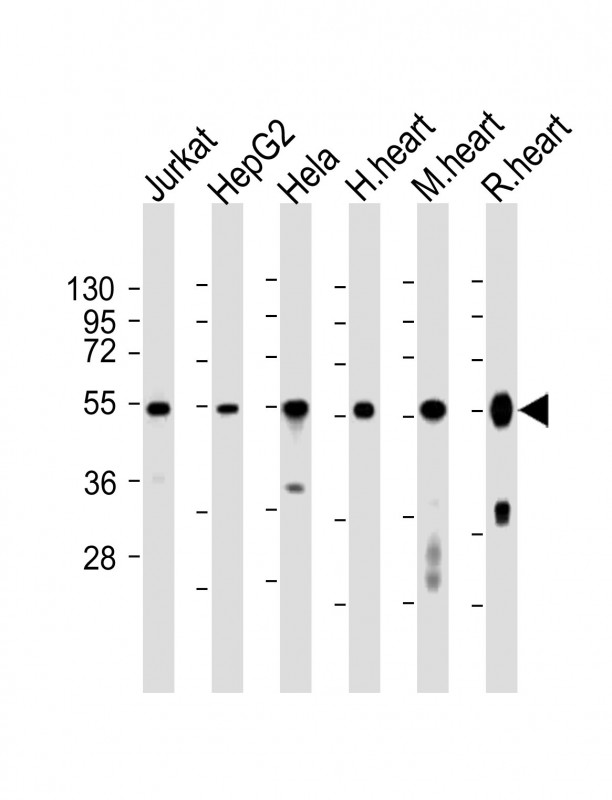OXCT1 Antibody (Center)
Purified Rabbit Polyclonal Antibody (Pab)
- 产品详情
- 文献引用 : 1
- 实验流程
- 背景知识
Application
| WB, E |
|---|---|
| Primary Accession | P55809 |
| Reactivity | Human, Rat, Mouse |
| Host | Rabbit |
| Clonality | polyclonal |
| Isotype | Rabbit IgG |
| Calculated MW | 56158 Da |
| Gene ID | 5019 |
|---|---|
| Other Names | Succinyl-CoA:3-ketoacid coenzyme A transferase 1, mitochondrial, 3-oxoacid CoA-transferase 1, Somatic-type succinyl-CoA:3-oxoacid CoA-transferase, SCOT-s, OXCT1, OXCT, SCOT |
| Target/Specificity | This OXCT1 antibody is generated from a rabbit immunized with a KLH conjugated synthetic peptide between 272-306 amino acids from the Central region of human OXCT1. |
| Dilution | WB~~1:2000 E~~Use at an assay dependent concentration. |
| Format | Purified polyclonal antibody supplied in PBS with 0.09% (W/V) sodium azide. This antibody is purified through a protein A column, followed by peptide affinity purification. |
| Storage | Maintain refrigerated at 2-8°C for up to 2 weeks. For long term storage store at -20°C in small aliquots to prevent freeze-thaw cycles. |
| Precautions | OXCT1 Antibody (Center) is for research use only and not for use in diagnostic or therapeutic procedures. |
| Name | OXCT1 |
|---|---|
| Synonyms | OXCT, SCOT |
| Function | Key enzyme for ketone body catabolism. Catalyzes the first, rate-limiting step of ketone body utilization in extrahepatic tissues, by transferring coenzyme A (CoA) from a donor thiolester species (succinyl-CoA) to an acceptor carboxylate (acetoacetate), and produces acetoacetyl-CoA. Acetoacetyl-CoA is further metabolized by acetoacetyl- CoA thiolase into two acetyl-CoA molecules which enter the citric acid cycle for energy production (PubMed:10964512). Forms a dimeric enzyme where both of the subunits are able to form enzyme-CoA thiolester intermediates, but only one subunit is competent to transfer the CoA moiety to the acceptor carboxylate (3-oxo acid) and produce a new acyl- CoA. Formation of the enzyme-CoA intermediate proceeds via an unstable anhydride species formed between the carboxylate groups of the enzyme and substrate (By similarity). |
| Cellular Location | Mitochondrion {ECO:0000250|UniProtKB:B2GV06}. |
| Tissue Location | Abundant in heart, followed in order by brain, kidney, skeletal muscle, and lung, whereas in liver it is undetectable Expressed (at protein level) in all tissues (except in liver), most abundant in myocardium, then brain, kidney, adrenal glands, skeletal muscle and lung; also detectable in leukocytes and fibroblasts |
For Research Use Only. Not For Use In Diagnostic Procedures.

Provided below are standard protocols that you may find useful for product applications.
BACKGROUND
Key enzyme for ketone body catabolism. Transfers the CoA moiety from succinate to acetoacetate. Formation of the enzyme-CoA intermediate proceeds via an unstable anhydride species formed between the carboxylate groups of the enzyme and substrate.
REFERENCES
Kassovska-Bratinova S.,et al.Am. J. Hum. Genet. 59:519-528(1996).
Fukao T.,et al.Genomics 68:144-151(2000).
Schmutz J.,et al.Nature 431:268-274(2004).
Ota T.,et al.Nat. Genet. 36:40-45(2004).
Reymond M.A.,et al.Submitted (FEB-1997) to UniProtKB.
终于等到您。ABCEPTA(百远生物)抗体产品。
点击下方“我要评价 ”按钮提交您的反馈信息,您的反馈和评价是我们最宝贵的财富之一,
我们将在1-3个工作日内处理您的反馈信息。
如有疑问,联系:0512-88856768 tech-china@abcepta.com.






















 癌症的基本特征包括细胞增殖、血管生成、迁移、凋亡逃避机制和细胞永生等。找到癌症发生过程中这些通路的关键标记物和对应的抗体用于检测至关重要。
癌症的基本特征包括细胞增殖、血管生成、迁移、凋亡逃避机制和细胞永生等。找到癌症发生过程中这些通路的关键标记物和对应的抗体用于检测至关重要。 为您推荐一个泛素化位点预测神器——泛素化分析工具,可以为您的蛋白的泛素化位点作出预测和评分。
为您推荐一个泛素化位点预测神器——泛素化分析工具,可以为您的蛋白的泛素化位点作出预测和评分。 细胞自噬受体图形绘图工具为你的蛋白的细胞受体结合位点作出预测和评分,识别结合到自噬通路中的蛋白是非常重要的,便于让我们理解自噬在正常生理、病理过程中的作用,如发育、细胞分化、神经退化性疾病、压力条件下、感染和癌症。
细胞自噬受体图形绘图工具为你的蛋白的细胞受体结合位点作出预测和评分,识别结合到自噬通路中的蛋白是非常重要的,便于让我们理解自噬在正常生理、病理过程中的作用,如发育、细胞分化、神经退化性疾病、压力条件下、感染和癌症。






